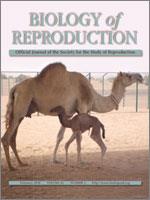The deduced amino acid sequence of bull sperm, SPAM1, suggests that it possesses a transmembrane domain between the hyaluronidase and the putative zona pellucida (ZP) binding domains. The objective of this study was to determine the orientation and localization of SPAM1 in order to understand how it could fulfill these two roles. We report that two isoforms of SPAM1 are present on ejaculated bull spermatozoa: one localized on the anterior portion of the sperm head, and the other on the postacrosomal portion of the head. The first isoform is expressed intracellularly, while the second one is detected at the sperm surface with its hyaluronidase domain facing the extracellular environment. Two-dimensional electrophoresis revealed that the two isoforms have different masses (80 and 70 kDa, respectively), and LC/MS/MS analyses confirmed our previously published deduced amino acid sequence of bovine SPAM1. In addition, this approach showed that the 70-kDa isoform differs from the 80-kDa isoform in its C terminus. Our results suggest that the shorter SPAM1 form originates from the epididymis, while the longer one is produced during spermatogenesis. These results clearly demonstrate that ejaculated bull sperm possess two forms of SPAM1: one (epididymal) expressed at the surface, and one (testicular) that interacts with the ZP after the acrosome exocytosis.
How to translate text using browser tools
7 October 2009
SPAM1 Isoforms from Two Tissue Origins Are Differentially Localized Within Ejaculated Bull Sperm Membranes and Have Different Roles During Fertilization
Guillaume Morin,
Robert Sullivan,
Isabelle Laflamme,
Claude Robert,
Pierre Leclerc
ACCESS THE FULL ARTICLE

Biology of Reproduction
Vol. 82 • No. 2
February 2010
Vol. 82 • No. 2
February 2010
acrosome
epididymis
fertilization
gamete biology
gamete interaction
hyaluronidase
p80




